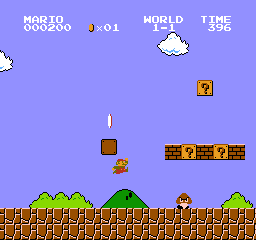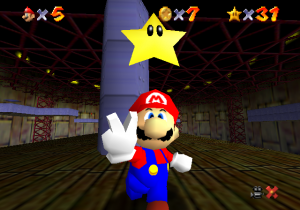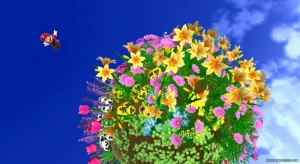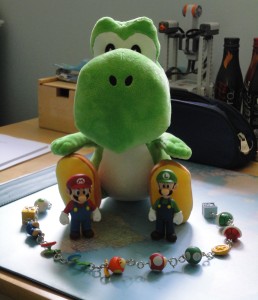Sep 10
24
New blog about the Wii’s successor!
I’ve set up a new blog, sorta to replace this one (though I may turn this one into a place where I post personal essays and such). It’s going to be about the Wii’s inevitable successor and I’ve got really big plans for it in the future. I’d like you to check it out, and hopefully subscribe to it; I aim to make it the world’s #1 resource about everything there is to know about the “Wii 2” (or whatever they’re gonna call it).
Note that the site hasn’t officially launched yet; hence, why it doesn’t have its own domain. I will purchase a domain for it and move the site there as soon as we get some kind of official word from Nintendo about a codename or something.
Jun 10
30
A New Hope for a New Yoshi’s Island
This is the post-E3 follow-up article to this one. It’s published externally, and proudly so, by Nintendo3DS.org.uk. Please read and comment on it there.
Note: E3 is over, and this game was not announced there. I’ve written a follow-up to this article, though, which introduces a few more clues that the game may still, in fact, be on its way. Check it out!
With the recent release of Super Mario Galaxy 2, the sequel that has now shamelessly become my new favourite game (that honour previously went to the original Super Mario Galaxy), I have begun to think about the inevitable continuation of the Mario series. Some evidence I’ve found suggests that we may very well be in for a real treat with the next installment; namely, a new entry in the Yoshi subseries. There are many ways they could name it: Super Yoshi Galaxy, Super Mario Galaxy 3: Yoshi’s Planet, Yoshi’s Island 3DS, but I’ll get to that. Let me go over all the little nuggets of potential evidence I’ve found that this game may very well be in the works.
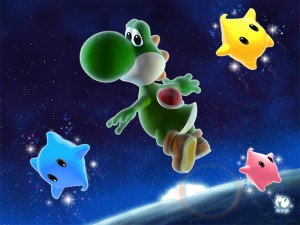
It sounds very far-fetched at first, but a Super Mario Galaxy 2 follow-up starring Yoshi may not be so far away at all... (image: chaMELeONtheARTIST @ deviantART)
Clue #1
Logical naming scheme; logical fit for the system
The Nintendo 3DS is due to come out within a year from now. The system’s graphical capabilities are said to be at or beyond the level of the GameCube, possibly even coming close to, or beyond the Wii’s. This is actually a fair bit of horsepower, especially for a handheld, and is certainly enough to faithfully reproduce the smooth, detailed, whimsical visuals the two Super Mario Galaxy games are known for. Some sacrifices may need to be made to get it running smoothly in 3D, especially as far as texture size and poly count are concerned, but remember that this will be a game you’ll play on sub-4-inch displays, not a 60-inch television set!
Super Mario Galaxy would be a perfect fit for the system. The 3DS’s killer feature is its 3D graphics. What better way to show these off with than a third entry in the fantastic franchise? The colourful worlds, numerous planetoids, and solid art direction will stand out, and 3D is just about the only thing that could make them look better than they already are. With a name like the Nintendo 3DS, it only makes sense name a game after the system, à la Super Mario 64 (this is, of course, assuming that “Nintendo 3DS” actually turns out to be the system’s real name, after all). Following is a list of possible names for the game I’ve come up with, and my comments on each.
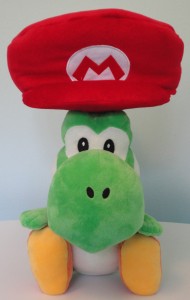
The first Yoshi's Island was originally released in Mario's shadow to profit off of the of the hype surrounding Super Mario World.
Super Mario Galaxy 3DS: Yoshi’s Planet
This name suggests that the game’s worlds are planet-like: vast and expansive, as opposed to the planetoid-size worlds from the previous two Galaxy games. Much like the original Super Mario World 2: Yoshi’s Island, this game may bear the name of its predecessor, but be an entirely different experience.
Super Mario Galaxy 3DS: Yoshi’s Island
It sounds too similar to Yoshi’s Island, and doesn’t feel quite right, since that name has already been used as a subtitle for a Mario game. An island also doesn’t even remotely fit with the space theme established in the Galaxy games, either, but Nintendo’s been known to make weird decisions before. coughcoughthewiianditsmotioncontrolscoughcough
Super Mario Galaxy 3DS: Yoshi’s Universe
Very unlikely to happen, since it would be attributing an entire universe to the little, happy-go-lucky dinosaurs, but who knows? Nintendo is well-known for their wonderful surprises.
Super Mario Galaxy 3DS: Yoshi’s Galaxy
Same argument as above, but this one’s slightly more probable, if only because a galaxy is a smaller body than, well, a whole universe. But the word “galaxy” feels redundant when used twice like this.
Yoshi’s Galaxy
The above name, minus the Super Mario Galaxy surtitle. The word “galaxy” doesn’t feel redundant in this version of the name, and even suggests a bigger, expanded re-imagining of Yoshi’s Island, what with galaxies being as astronomical as they are (exceedingly lame pun intended).
Super Yoshi Galaxy
This one sounds about right, but the Yoshi subseries has never had the word “super” as part of the name. That honour always went to Mario. On the other hand, the “super” suggests that the game is much more than another installment in the perpetually-nomming dinos’ series, a point I was emphasizing with the name Yoshi’s Galaxy.
Yoshi’s Island 3DS
The revered Yoshi’s Island name stands much better on its own rather than as the subtitle of its parent series, Mario. Attaching the 3DS moniker to it feels natural, since DS was tagged onto what was originally known asYoshi’s Island 2; and besides, it makes sense for the number three to be part of the name, since this game will be the third entry in its series.
Clue #2
History is repeating itself.
The 2D Mario games formed a pattern that is now repeating in the 3D ones. Yoshi is next.
This isn’t too obvious at first, but when you think about it, you’ll see that the 2D Mario games formed a distinct pattern that is very much evident in the 3D ones. Every 2D game has had a corresponding 3D one, matching it in various qualities like adherence to an established formula, straying from it, being thematically different, and so on and so forth. Yoshi’s own adventure is up next. I can explain it best by listing them off and commenting on each pair of games.
Note: Following are some meticulously detailed comparisons between all the “main-series” 2D and 3D Mario games. If you don’t have the patience to read all of it, or just want to get to the point, I’ve written a short summary of it all further down the page, right before clue #3.
Super Mario Bros. = Super Mario 64
This was the first game in the series; a brand-new experience for gamers like none they had ever had before. Both of these games have also launched systems, not only being great games on their own, but serving as technical showpieces for their respective consoles, too.
Super Mario Bros. was one of — if not the — first side-scrolling platformers, and introduced almost everything our favourite plumber duo is known for today. The 1-Up and super mushrooms as well as the fire flower, three of the most widely recognized power-ups in gaming history, got their start here, and have stuck with 2D Mario games since (and eventually even made it into the 3D ones). Bowser (known as King Koopa back then) kidnapped Princess Peach (who was also introduced here) for the first of many, many times, and the kindhearted Mario set out to save her. The game was also technically impressive for its time, boasting eight worlds crammed into a single NES cartridge, and scrolling backgrounds — a feature that was almost unheard of before the NES came along, mainly due to hardware restrictions.
Likewise, Super Mario 64 gave us Mario’s famous 3D moveset that included the triple jump, backflip, side flip, long jump, wall kick, and ground-pound (often jokingly called the butt stomp) — moves that are now synonymous with Mario’s name, and have since become staples of his 3D outings. Like Super Mario Bros., this game was also a launch title, and served to demonstrate many of the Nintendo 64’s key features: not just advanced 3D graphics (for the time; remember, it’s 1996 we’re talking about!), but perhaps more importantly, analog control. That little stick on your pad, be it for an Xbox 360, PlayStation 3, or the Wii’s nunchuk, exists primarily because of Super Mario 64‘s successful design around it. The game introduced us to a 3D rendition of Mario’s world for the first time, much like Super Mario Bros. showed us that his world went on past the border of the screen, and brought with it all sorts of new concepts and gameplay mechanics that made you reconsider everything you knew about video games from the SNES/SEGA Genesis era.
Super Mario Bros. 2 = Super Mario Sunshine
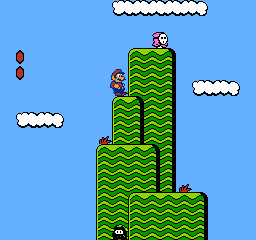
Here, Mario needs to pick up one of those vegetables in the ground and hurl it into the Shy Guy to kill it. Not very Mario-like, I know.
Super Mario Bros. 2 was a great game in its own right, but it strayed far off the framework that the original Super Mario Bros. laid down for the series. The games had their similarities, sure — they were both side-scrolling platformers — but this game was a completely different experience. It took place in a totally new world, with its own ecosystem of flora and fauna (it was here that Shy Guys were shown for the first time), and featured a brand-new graphical style. Save for the protagonists, almost nothing from Super Mario Bros. seemed to be in here. Moreover, it brought a new gimmick into play that seemingly replaced jumping on enemies in the first game: picking enemies or objects up and throwing them. Technically speaking, it wasn’t even originally a Mario game; rather, it was a reskinned version of a Japanese game called Doki Doki Panic!. The game was good fun and all, but was hammered by fans and critics alike for being too different from the successful formula established by its predecessor.
Super Mario Sunshine draws many similar comparisons with Super Mario 64. F.L.U.D.D. is the new gimmick here, and many of the game’s levels are built around tasks that force the player to use the backpack-like machine’s various water-shooting abilities. It worked well for the most part — save for some frustrating moments with the hover nozzle — and some may even go as far as to call it innovative, but Mario wearing a robotic, talking water pump strapped to his back just didn’t feel like a true Mario experience. The game also takes place on a tropical island, known as Isle Delfino, that is so far from the Mushroom Kingdom that it has had the chance to develop its own life forms and inhabitants. The enemies are all-new (and not quite as memorable as they were in previous designs), and instead of the cheerful Toads inhabiting the places Mario visits, you’ve got the big-boned Piantas and petite Nokis.
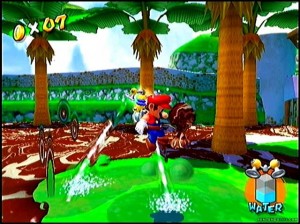
Muddy goop everywhere, and a water-powered hovering mechanism? Thanks, but no thanks. This is taking it a bit too far beyond what Mario is all about. (image: Nintendo Life)
While the Mario games’ worlds traditionally cover all the bases, from grasslands to deserts and all the wonderful stuff in between, Super Mario Sunshine‘s locales are all themed around places you’d find on a real tropical island: beaches, a native village, a stunningly beautiful bay, the ocean (duh!), and a merchant-filled city. Every now and then, the sunny visuals gave way to a more traditional-style level that featured a short obstacle course for the player to get through and a shine sprite at its end. This is the closest Super Mario Sunshine comes to replicating the classic Mario feel, as F.L.U.D.D. is taken away from you upon entering these “secret” areas (at least on your first visit to them), and the sunlight-drenched backdrops of the hot outdoors give way to a simple, generic background and a very linear, very straightforward task. As devilishly challenging as these sections can get, they still lack theme and something to truly set them apart. They feel like bonus levels — almost like minigames, in fact — that are not connected with the outdoor world in any way.
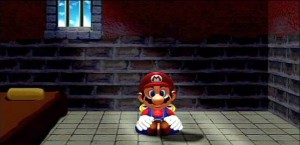
Super Mario Sunshine locked players down to a tropical island, with little variety as far as scenery went. (image: GameSpot)
Quite notably, Super Mario Sunshine also marked Yoshi’s debut in a 3D Mario platformer (not counting his brief cameo at the end of Super Mario 64). This is the one anomaly between it and its 2D sibling, as the latter didn’t include everyone’s favourite dinosaur, but it’s also important to note that this wasn’t the lovable, nearly-invincible Yoshi we had come to know and love from Super Mario World and Super Mario World 2: Yoshi’s Island. Indeed, just like Mario and F.L.U.D.D., Yoshi was plagued by a necessity to have a certain type of fruit in the immediate vicinity of his egg to hatch, an odd aversion to water that caused him to disintegrate into a muddy mess upon contact with the allegedly life-giving substance, and the questionable “juice” mechanic, where he regurgitates digestive acid and shoots it out of his mouth at high speed, temporarily replacing F.L.U.D.D.’s primary “squirt” function while riding him. This wasn’t the true Yoshi that his fans were expecting, but rather a completely re-imagined version. Re-imagined the wrong way, that is.
Super Mario Bros. 3 = Super Mario Galaxy
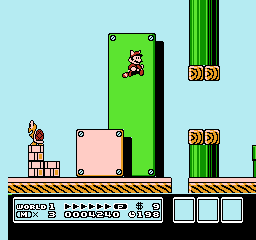
Not only was this a reboot of sorts for the Mario series, but it impressed greatly on the technical front, too.
Super Mario Bros. 3 harkened back to the original Super Mario Bros. You were fighting Goombas, Koopas, and Bowser once again, and you jumped on enemies to kill them rather than throwing them around.
Except that this game took everything that made the first game so damn fantastic and polished it to a blinding sheen. Levels were bigger and now scrolled in all directions; the graphics and sprite sets used varied far more from level to level, too. There were many more levels per world — now each with a distinct theme — and each and every one of them was a brand-new experience. The infamous soundtrack pushed the limitations of the NES sound chip further than ever before, and gamers were treated to one of the finest experiences on the aging system. It even famously introduced the map screen. Even to this day, people are still enjoying this game for all it offers.
Super Mario Galaxy did for the 3D Mario games what Super Mario Bros. 3 did for the 2D ones. It took the solid groundwork laid down by Super Mario 64 and — quite literally — shot for the stars. The basic moves and mechanics were still there: Mario had the same set of moves (and the long jump returned after its mysterious absence from Super Mario Sunshine), and was still running around a plethora of 3D areas on a quest to find all the Power Stars and save his beloved Princess Peach. Super Mario 64‘s infamous, broken camera was perfected. Just like Super Mario Bros. 3, and armada of airships transported Bowser’s countless troops, complete with their signature music — now a glorious orchestrated rendition.
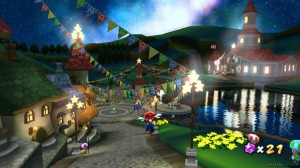
Nintendo didn't allow the Wii's lack of horsepower to stop them from crafting one of the most solid visual experiences of the decade. (image: Nintendo Life)
In fact, just like Super Mario Bros. 3 presented a fresh, new aural experience, Nintendo did it again with Super Mario Galaxy‘s jaw-dropping orchestrated soundtrack — a notable first for the legendary company. Upon booting up the game, a majestic fanfare greets the player, then leads into a beautiful piano solo. The player is then ushered into a stunning re-imagining of the Mushroom Kingdom. Peach’s castle is off in the distance, overlooking a lake, and the light from its windows have shimmering reflections in the water. The orchestra plays a delightfully cheerful piece as Mario eagerly runs towards the palace, anticipating Peach’s alleged present. But then, a large projectile shoots into a small tower, destroying it. The pounding drums and low brass kick in, and the camera zooms out to a sweeping shot from above.
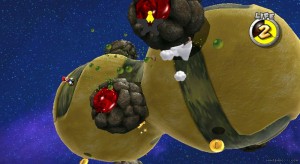
A planet from one of the earlier levels in the game. The new gravity system is fantastic, and works beautifully. (image: Nintendo Life)
Bowser’s forces arrive by airship in a cutscene, the majesty of which rivals everything Nintendo has ever crafted before, and at that moment, you realize that you’re in not just for another Mario game, but a very special one, too; one rebuilt from the ground up to please with all-new ideas around every corner without alienating the rabid Super Mario 64 fanbase. The 41 titular “galaxies” are constantly throwing new ideas and mechanics at you, much like Super Mario Bros. 3 constantly surprised the player from level to level. The new gravity mechanic is the new killer feature, much like the map screen and countless power-ups were in Super Mario Bros. 3. Super Mario Galaxy makes one think of game design in a whole new way, and has some of the highest production values on the Wii. The experience in both games is a delightfully fresh one, yet they know where their roots are in Super Mario 64 and Super Mario Bros., and respect them well.
Super Mario World = Super Mario Galaxy 2
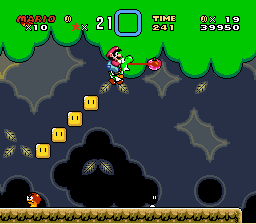
Super Mario World introduced us to Yoshi for the first time. No one saw it coming, but the green dino garnered enough star power of his own to get his own game a few short years later.
Now we get to Super Mario World, the sequel that could not be. The sequel that, against all odds, redid what its predecessor did, and not only got away with it, but became a game of its own, too. Much of what’s in here was already done in Super Mario Bros. 3, and what made that first game so great — a high-budget production, technically impressive graphics (looks quite dated nowadays, but remember that it was a launch title), the map screen (now, though, all the different locales were tied together into a single, greater world map, giving it a sense of connectedness), the pitch-perfect Mario mechanics — all of it’s back. The level of difficulty was toned down a bit, making the game a little more accessible to the not-so-hardcore, but it still presented a formidable challenge to those that wished to take every secret exit, find every single bonus level, and make it through the challenging Star Road.
Almost all of the above rings true for Super Mario Galaxy 2, too (pardon the rhyme), when one compares it to its prequel. It is, at its core, the same Super Mario Galaxy we got back in 2007: the Mario Galaxy Orchestra is back and in full swing, the engine still delivers some of the very best graphics on the Wii, and the game places an even greater emphasis on the addictive gravity-based puzzles this time around. Unlike Super Mario World, this game actually ramped up the difficulty quite significantly from the original Super Mario Galaxy, but it also introduced the Cosmic Guide; essentially, the game will beat a level for you (at the expense of not getting a proper golden star) if you’re having serious issues with it (read: if you’re a casual gamer).
Super Mario World and Super Mario Galaxy 2 have one more, very significant addition in common.
Yoshi.
Mario’s adorable dinosaur pal and lovable steed made his debut in Super Mario World, and underwent a much-needed reboot after his half-hearted appearance in Super Mario Sunshine. According to Miyamoto, the idea of Mario riding a dinosaur was conceptualized as soon as the overall-clad plumber was, but technical limitations prevented Nintendo from including Yoshi until the SNES rolled onto the scene.
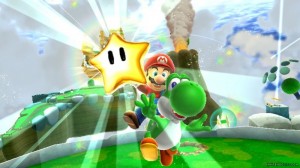
Yoshi is back, and this time, Nintendo figured out how to get him to control smoothly in 3D. (image: Nintendo Life)
Technically speaking, there was nothing preventing them from having Yoshi right off the bat in the first Super Mario Galaxy, but the Mario team is said to spend a year just fine-tuning the game’s basic mechanics. It’s understandable if they no longer had the patience to get Yoshi to feel right, too, after spending so long on Mario, and the last thing anyone wants is for them to pull another Sunshine. But for Super Mario Galaxy 2, the basic mechanics were simply recycled from the first game (and rightfully so, since they pretty much nailed them the first time around). They had the time and resources to think Yoshi’s addition through properly and tune his moves. And the result? One of his finest implementations yet, if one discounts the relative rarity of his appearances.
Yoshi added a lot to both of these games, from numerous special abilities of his own to his long tongue and seemingly insatiable appetite for Mario’s enemies. Both games featured entire levels built around the irresistibly cute dino’s skills; and whenever Mario seated himself upon his back, one could almost feel the extra power, the extra freedom, but most importantly, the extra fun that Yoshi added.
You know what’s next…
Super Mario World 2: Yoshi’s Island = ???
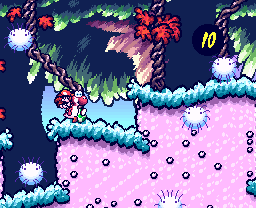
The infamous "Touch Fuzzy, Get Dizzy" level. Just take a moment to imagine how much better it would be in 3D...
Super Mario World 2: Yoshi’s Island was the swansong of the 2D Mario games, the last one before Super Mario 64 boldly took the series (and all of gaming with it) into a whole new dimension. As the last significant 2D Mario game for the next decade (until New Super Mario Bros. came along), Shigeru Miyamoto’s team — which had previously delivered all of the above sidescrollers — gave it their all to ensure it was the definitive one. They wanted the 2D series to go out with a bang, and the result was one of the most strikingly artistic and creative games ever made; a game so great, it set the new standard for every platformer that was to follow. Such a statement is not made lightly, and it is amazing to think the team still had it left in them after all those older Mario games, especially Super Mario World.
But to call it a sequel to that [admittedly amazing] game is an understatement. While the game’s title certainly may make one think so, the true fact of the matter is that Nintendo only wished to attach it to the Super Mario World name to piggyback off of the overwhelming popularity and positive reception of that game. Yoshi’s Island, however, was a Mario game only in the loosest of terms. It was conceived when Yoshi began gathering quite a significant following after his debut in Super Mario World. There, he was a “horse” for Mario to ride on, confined to an egg until freed by the courageous plumber, and always forced to obey his command. But the green-skinned dinosaur garnered enough fans to warrant a game of his own. Enter Yoshi’s Island. Here, Mario was tossed aside into the submissive role — just a baby on Yoshi’s back. The player was now in direct control of Yoshi, and could make use of his various abilities (one of which, the ground-pound, carried over to Mario and co., too) like the flutter jump, the ability to swallow enemies and turn them into eggs, and to throw said eggs, to traverse the expansive levels and solve the simple, albeit fun puzzles. The levels on display here, even though they were still left-to-right linear, were much larger and encouraged exploration, as there were all sorts of collectibles to find. In Super Mario World, there were five
dragon coins for those willing to look around. Yoshi’s Island, however, had five flowers, 20 red coins, and 20 yellow stars for the player to find in every level; quite the job even for the hardiest of completionists.
The game did not just offer an unprecedented level of fun that lasted a surprisingly long time, but also served as quite the technical showpiece. It made use of the Super FX 2 chip; essentially, a graphics processor built into the game’s cartridge that allowed the SNES to use of all sorts of then-unheard-of effects like sprite transformation and [relatively simple] polygonal 3D graphics. The game’s unforgettable art style owes it all to this chip, which allowed the vibrant pastel worlds of Yoshi’s Island to come to life in ways not possible (at the time) by any other means. The game provided one of the nicest-looking and technically advanced visual experiences of the time, and made use of the chip’s extra power to make way for some astonishingly clever level designs.
Fast-forward to the near future: a new Yoshi’s Island-type game would be a perfect fit for the Nintendo 3DS. True, it may not be the handheld’s swansong; quite to the contrary, it may be its big launch title, but if it’s designed to push the boundaries of its system’s hardware — akin to how Yoshi’s Island showed us what the SNES could really do — that may just make it all the more appropriate. A new Yoshi game, with its lush vistas and silky-smooth animation, all in glasses-free 3D, may just be what we, the consumers, are looking for as proof of the 3DS concept.
Moreover, Nintendo has adhered very closely to the 2D games’ history with the 3D ones. Here’s a short summary of everything up above in this section, to help you get the point:
- First Mario game; a brand-new, fresh experience; introduces the series, and a console
- Sequel, but is the odd one out in the series for being too different from the original
- Sequel; this time, harkens back to the glory days of the first game, but takes it to new heights
- Sequel: [re-]introduces Yoshi, and reuses much of the inspiration behind its predecessor, but is an experience all its own.
- Half-sequel; is a full-on Yoshi game. You control Yoshi, not Mario. May be attached to the Mario name, but proves that Yoshi can stand alone on his own. Is also stunning on the technical level, and serves as an example of what its system can really produce.
See what I mean? The first four happened in that order…both in 2D and 3D. Why break the pattern now? Unless Nintendo decides to, for some reason, go in a completely different direction with the Mario series (and with it, the Yoshi subseries), the next “Mario” game will, in fact, actually be a Yoshi game. It makes perfect sense, especially when one considers my other finds, too.
Clue #3
Charles Martinet’s long-forgotten, now-deleted tweets
Sometime back in October, the voice actor behind the Mario Brothers made several interesting tweets regarding a new Mario game (via Gaming Target):
October 10
“Mama Mia!!!! I’m going to Seattle this week to record a new Mario game! Woo Hooo!!!!! I can hardly wait!!!!1”
October 12
“Big day tomorrow! Seattle for a new Mario game! Yippee!!! And just as a joke, it’s going to rain….in San Francisco tomorrow!”
October 17
“Awesome new Mario Game! And it’s not NSMB Wii, and it’s not Galaxy 2, but it’s going to be crazy fun!”
The first two could’ve passed for New Super Mario Bros. Wii or Super Mario Galaxy 2, but the last tweet proves otherwise. All three tweets have since been deleted, presumably by Nintendo’s request, but word got out quick and countless sites have since immortalized them.
Some rumours speculate that the game in question is a new entry in the popular Mario Party series, which is several years overdue for a new installment. But the recently announced Wii Party looks like it will replace the dormant series, and with all the other evidence I’ve found, a new game starring Yoshi and his kind appears to be far more likely.
In case you’re curious, here’s a link to Charles Martinet’s Twitter page, but you won’t find these tweets there. Rumour has it that Nintendo forced him to delete them to keep the game a secret, but they were obviously too late for that.
Clue #4
An odd anomaly on the Super Mario Galaxy 2 title screen
I know it may sound odd that I’m citing a title screen as a source of evidence, but allow me to explain. Here, Yoshi is clearly seen flying around space on his own, without Mario riding him. You’re probably thinking, “Yoshi is flying around by himself. What of it?”
True, it sounds rather trivial when you think of it like that, but this design choice’s significance becomes apparent when you realize that there isn’t a single piece of official Super Mario Galaxy 2 artwork that shows Yoshi without Mario riding him.
Believe me, I’ve looked far and wide, with no luck.
Whenever Nintendo shows Yoshi in any material pertaining to Super Mario Galaxy 2, Mario is always riding him. Not just that, but the only time Yoshi is even ever seen in-game without Mario on his back is when he’s waiting for the portly plumber to hop on, and when he hastily introduces himself when you first find him.
This begs the question: why is Yoshi suddenly seen by himself on the title screen, away from Mario, doing as he pleases instead of being forced to obey the mustached man’s command as one would expect from all the promotional media of the game?
It’s a very odd design choice, one certainly not made arbitrarily. At first, it comes off as a purely cinematic effect, to not have the three characters on the title screen flying together in a pack, but then, wouldn’t it be logical to separate the Co-Star Luma from Mario, too? He’s never seen not following Mario, either, outside of Starship Mario and the game’s logo. To me, Yoshi’s separation here is a sign of things to come; a subtle hint from Nintendo that he’s about to get his own game once again…
Other hopes…
Many of us are impatiently waiting for Super Mario World 2: Yoshi’s Island to make its long-awaited appearance on the Wii’s Virtual Console service. Some people believe that the reason for this is that the mandatory Super FX 2 chip is proving to be exceedingly difficult to emulate on the Wii, but one has to remember that Nintendo has some of the best programmers in the industry working for them, and that the Wii is leaps and bounds ahead of the SNES in horsepower; there’s no way it can possibly take them the three and a half years since the Wii’s launch to figure it out.
This leaves a second reason for the game’s absence open; namely, that they are holding it back so as to release it together with the new Yoshi game for the 3DS that this whole article is trying to prove. Nintendo used this promotional strategy before by giving us the “Month of Metroid” before the release of the amazing Metroid Prime 3: Corruption. During that time, they released Metroid and Super Metroid, — for the NES and SNES, respectively — which clearly profited off the hype for Corruption, and gave us the Metroid Prime 3: Corruption Preview Channel, a channel dedicated to videos of the much-anticipated end to the fabled trilogy.
Quite possibly, they are preparing to do something similar with this new Yoshi game, and will release the Virtual Console version of Yoshi’s Island shortly before the third entry in the series hits. So many fans are begging for this game, and Nintendo usually listens to those requests, as they have before with Super Mario RPG: Legend of the Seven Stars, The Legend of Zelda: Majora’s Mask, and Super Smash Bros., so this is pretty much the only way to rationalize their delaying of its inevitable Wii re-release.
On another note, IGN recently wrote a massive, 12-page article about Yoshi’s history to commemorate his 20th anniversary. On the last page, they mentioned this:
“It’s hard to say where Yoshi will end up next. Coming off 2010’s with Super Mario Galaxy 2, it’s possible that Nintendo will once again tap the character for more individual adventures — capitalizing on his momentum and bringing the name of Yoshi back to box arts, instead of just his likeness. Our walk back through time has certainly given us ample evidence of that happening in the past — several of these spin-offs and extra appearances wouldn’t have existed if not for the success of a core Mario adventure, starring Yoshi, immediately prior to them.”
I’m not the only one who’s hopeful for a new Yoshi game, and even IGN sees it as possible. Nintendo has always had a reputation for surprising us, throwing us incredible new games no one expects. Here, I’m hoping to have caught them in the act for once, anticipating their next out-of-the-blue production. Many people have been clamouring for reboots of other long-dormant Nintendo series like Kid Icarus, Pikmin, and Starfox, but there is already so much noise about those that it won’t be enough of a surprise for Nintendo to reveal a continuation of those beloved franchises. Now, a new Yoshi game will be a curveball no one saw coming; no one that hasn’t read this article, that is.

Since his introduction in 1991's Super Mario World, Yoshi has gone on to headline a series of games that is all his own. Perhaps a new installment isn't as far away as it seems... (image: IGN)
The original Yoshi’s Island hit us like this, as a bit of a surprise, and so did its sequel, Yoshi’s Island DS, releasing only five months after its unveiling at E3 2006. Nintendo may show us Yoshi’s Island 3DS (or whatever they choose to call it; see clue 1) on Tuesday as the system seller for the Nintendo 3DS. Let’s keep our fingers crossed that Super Mario Galaxy 2 was only a teaser of the next-generation Yoshi that will be fully realized on new hardware; Super Mario World first introduced him to the world, but it took a brand-new piece of technology called the Super FX 2 chip to make him come into his own. Super Mario Galaxy 2 is this generation’s Super Mario World, and the 3DS is its Super FX 2. Only the obligatory Yoshi-starring follow-up is missing from the picture.
Tuesday, June 11 will reveal all…
Don’t forget to leave your thoughts and comments below!
Posted in Gaming by .
May 10
22
Genesis of the Feldian Blog
Hello to my all my faithful followers (of which there aren’t really any)!
To celebrate the recent move to my new server, I set up a personal blog! This will be the place I write about interesting stuff I see on the internet or that happens to me in real life!
I hope I get some readers. I’m already well into my first article!
